Running Friction
High running friction may cause difficulty by wearing soft metal parts. Metals such as copper, brass or aluminum can be rapidly worn away by a moving O-ring. This is especially true if high pressures are involved. If unexplained leakage occurs with these or other soft metals, it is good practice to check the metal dimensions for signs of wear.
The following formulas may be used for estimating the running friction of O-ring.
Piston Groove Rod Groove
FC = fc x Lp FC = fc x Lr
FH = fh x Ap Fh = fh x Ar
F = FC + FH F = Fc + FH
Ap = Projected area of seal for piston groove
applications.
Ar = Projected area of seal for rod groove applications.
F = Total seal friction in pounds.
FC = Total friction due to seal compression.
FH = Total friction due to hydraulic pressure on the seal.
fc = Friction due to O-ring compression obtained from
Figure 5-9.
fh = Friction due to fluid pressure obtained from Figure 5-10.
Lp = Length of seal rubbing surface in inches for piston
groove applications.
Lr = Length of seal rubbing surface in inches for
rod groove applications.
Example:
Parker 2-214 rubbing against OD of O-ring at 103.5 Bar (1500 psi), 10% compression, 70 durometer:
FC = 0.7 x 3.93 = 2.75
FH = 48 x 0.44 = 20.90
F = FC + FH = 23.65 pounds
Data for the coefficients (fc and fh) are given in Figures 5-9 and 5-10. Projected areas and lengths of rubbing surface are given in Table 5-4.
 |  | |
|
Figure 5-9: Friction Due to O-ring Compression |
Figure 5-10: Friction Due to Fluid Pressure |
Table 5-4: Rubbing Surface for O-rings
Parker Hannifin
O-Ring Division
2360 Palumbo Drive
Lexington, KY 40509
Ph: 859-269-2351
Fax: 859-335-5128
ordmailbox@parker.com
www.parkerorings.com


